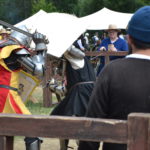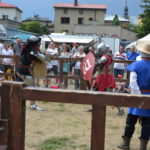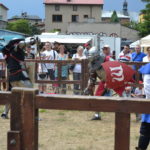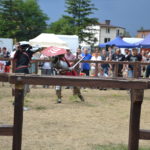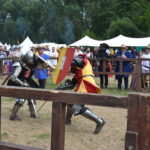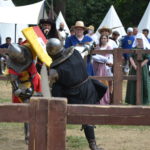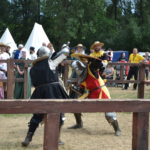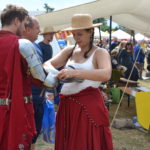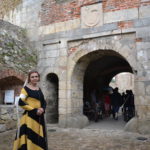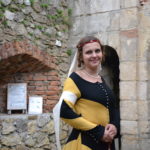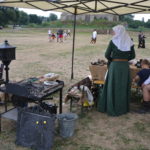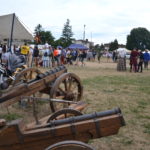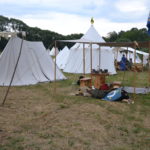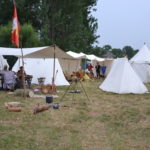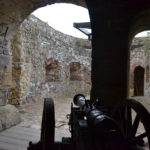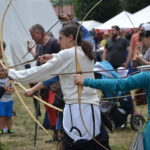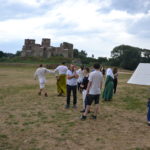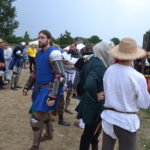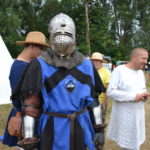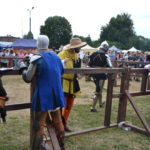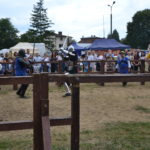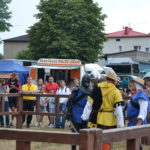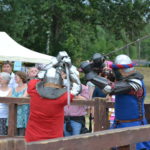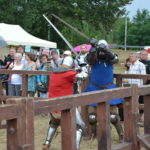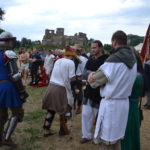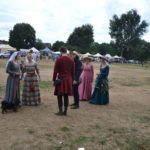This year tournament at the walls of Siewierz Castle hosted more than two hundreds medieval reenactors. Piotr Kriger won both – the longsword and the sword and shield competition.
8th Knights’ Tournament in Siewierz Castle just ended. Since its very beginning organizers aimed to connect reenactors of high and late middle ages. Last weekend fields at the walls of ruins of the Siewierz Castle were home to some 250 reenactors from Southern Poland.
“When it became such a big thing – it’s a mystery to me”, says Monika Banach Kokoszka, Vice President of the Duchy of Siewierz Banner (Chorągiew Rycerska Księstwa Siewierskiego). “Some say out tournament is the biggest one in the Southern Poland. We have guest even from such places as Warsaw. 3 years ago we had the high score: 348 reenactors”.
“Our association is involved not only in middle ages but also in 17th, 19th and 20th century reenactment. I myself am reenactor for 20 years, I’ve also studied history. My bond with middle ages is very emotional and there’s no logical reason for it – only the reasons of heart”, she adds.
There are several competitions within the tournament: longsword, sword and shield and grappling. There’s also sport sword competition for children – with a go-now swords and head protection. There were a “Grażyna Tournament” in past editions: in honor of Adam Mickiewicz’s Grażyna, an armed woman who fought against Teutonic Order. But unfortunately there’s not so much fighting women in reenactment. On the other hand organizers are thinking about “Young Damsels’ Race”, for many reenactors participate in events together with their kids.
This year winners of Siewierz Tournament are:
- Archery competition: Jacek Łabęcki
- 3vs3 buhurt combat: Sierotki
- Damsels’ Race: Agami
- Grappling: Robert Derus
- 13th century 1vs1 combat: Krzysztof Baran from Tarnów
- Longsword: Piotr Kriger
- Sword and shield: Piotr Kriger
- Monika Banach Kokoszka
- Monika Banach Kokoszka
Siewierz, as a trade settlement, arose in 1125. Castellan stronghold was built in 14th century on a man-made hilltop, where formerly stood a wooden fortress. The oldest of the stronghold’s fortifications come from the fifteenth century. In the 1790 the Great Sejm formally incorporated the Duchy as a Land of the Polish Crown into the Polish–Lithuanian Commonwealth and the abandoned castle decayed. The last resident of the castle, Feliks Paweł Turski, left the residence in 1800. The only reason the building did not diminish is due to extensive reconstruction and renovation works in the 1950s, 1970s, and 1990s.
“The castle won’t be reconstructed. Athens and Venice Charters forbid reconstructing monuments. Siewierz Castle wasn’t destroyed during the military activities but fallen into decay. It was perceived as a remembrance of the past already in the 19th century”, says historic preservation officer of Siewierz Artur Rok.
“I see it as a right direction. A relic is something our ancestors left behind. We can’t recreate a Rembrandt painting for it won’t be a Rembrandt painting. We can’t build new fortifications in 21st century and say it’s medieval castle”, he explains.


